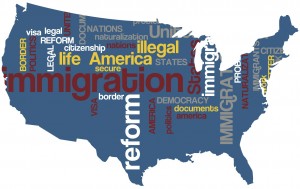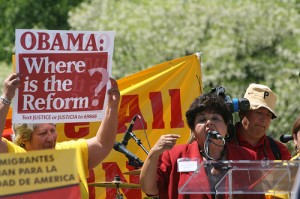The following is the latest on Executive Action from uscis.gov:
On November 20, 2014, the President announced a series of executive actions to crack down on illegal immigration at the border, prioritize deporting felons not families, and require certain undocumented immigrants to pass a criminal background check and pay taxes in order to temporarily stay in the U.S. without fear of deportation.
These initiatives include:
- Expanding the population eligible for the Deferred Action for Childhood Arrivals (DACA) program to young people who came to this country before turning 16 years old and have been present since January 1, 2010, and extending the period of DACA and work authorization from two years to three years
- Allowing parents of U.S. citizens and lawful permanent residents who have been in the country since January 1, 2010, to request deferred action and employment authorization for three years, in a new Deferred Action for Parental Accountability program, provided they pass required background checks
- Expanding the use of provisional waivers of unlawful presence to include the spouses and sons and daughters of lawful permanent residents and the sons and daughters of U.S. citizens
- Modernizing, improving and clarifying immigrant and nonimmigrant programs to grow our economy and create jobs
- Promoting citizenship education and public awareness for lawful permanent residents and providing an option for naturalization applicants to use credit cards to pay the application fee
| Important notice: These initiatives have not yet been implemented, and USCIS is not accepting any requests or applications at this time. Beware of anyone who offers to help you submit an application or a request for any of these actions before they are available. |
Next steps
USCIS and other agencies and offices are responsible for implementing these initiatives as soon as possible. Some initiatives will be implemented over the next several months and some will take longer.
Over the coming months, USCIS will produce detailed explanations, instructions, regulations and forms as necessary. The brief summaries provided below offer basic information about each initiative.
While USCIS is not accepting requests or applications at this time, if you believe you may be eligible for one of the initiatives listed above, you can prepare by gathering documents that establish your:
- Identity;
- Relationship to a U.S. citizen or lawful permanent resident; and
- Continuous residence in the United States over the last five years or more.
Below are summaries of major planned initiatives by USCIS, including:
- Who is eligible
- What the initiative will do
- When you can begin to make a request
- How to make a request
| 1. Deferred Action for Childhood Arrivals (DACA) program |
| Who |
- Current DACA recipients seeking renewal and new applicants, including individuals born prior to June 15, 1981, who meet all other DACA guidelines.
|
| What |
- Allows individuals born prior to June 15, 1981, to apply for DACA (removing the upper age restriction) provided they meet all other guidelines.
- Requires continuous residence in the United States since January 1, 2010, rather than the prior requirement of June 15, 2007.
- Extends the deferred action period and employment authorization to three years from the current two years.
|
| When |
- Approximately 90 days following the President’s November 20, 2014, announcement.
|
|
|
| 2. Deferred action for parents of U.S. citizens and lawful permanent residents |
| Who |
- An undocumented individual living in the United States who, on the date of the announcement, is the parent of a U.S. citizen or lawful permanent resident and who meets the guidelines listed below.
|
| What |
- Allows parents to request deferred action and employment authorization if they:
- Have continuous residence in the United States since January 1, 2010;
- Are the parents of a U.S. citizen or lawful permanent resident born on or before November 20, 2014; and
- Are not an enforcement priority for removal from the United States, pursuant to the November 20, 2014, Policies for the Apprehension, Detention and Removal of Undocumented Immigrants Memorandum.
Notes: USCIS will consider each request for Deferred Action for Parental Accountability (DAPA) on a case-by-case basis. Enforcement priorities include (but are not limited to) national security and public safety threats. |
| When |
- Approximately 180 days following the President’s November 20, 2014, announcement.
|
|
|
| 3. Provisional waivers of unlawful presence |
| Who |
- Undocumented individuals who have resided unlawfully in the United States for at least 180 days and who are:
- The sons and daughters of U.S. citizens; and
- The spouse and sons or daughters of lawful permanent residents.
|
| What |
- Expands the provisional waiver program announced in 2013 by allowing the spouses, sons or daughters of lawful permanent residents and sons and daughters of U.S. citizens to get a waiver if a visa is available. There may be instances when the qualifying relative is not the petitioner.
- Clarifies the meaning of the “extreme hardship” standard that must be met to obtain a waiver.
Notes: Currently, only spouses and minor children of U.S. citizens are allowed to apply to obtain a provisional waiver if a visa is available. |
| When |
- Upon issuing of new guidelines and regulations.
|
|
|
| 4. Modernize, improve and clarify immigrant and nonimmigrant programs to grow our economy and create jobs |
| Who |
- U.S. businesses, foreign investors, researchers, inventors and skilled foreign workers.
|
| What |
USCIS will:
- Work with the Department of State to develop a method to allocate immigrant visas to ensure that all immigrant visas authorized by Congress are issued to eligible individuals when there is sufficient demand for such visas.
- Work with the Department of State to modify the Visa Bulletin system to more simply and reliably make determinations of visa availability.
- Provide clarity on adjustment portability to remove unnecessary restrictions on natural career progression and general job mobility to provide relief to workers facing lengthy adjustment delays.
- Clarify the standard by which a national interest waiver may be granted to foreign inventors, researchers and founders of start-up enterprises to benefit the U.S economy.
- Authorize parole, on a case-by-case basis, to eligible inventors, researchers and founders of start-up enterprises who may not yet qualify for a national interest waiver, but who:
- Have been awarded substantial U.S. investor financing; or
- Otherwise hold the promise of innovation and job creation through the development of new technologies or the pursuit of cutting-edge research.
- Finalize a rule to provide work authorization to the spouses of certain H-1B visa holders who are on the path to lawful permanent resident status.
- Work with Immigration and Customs Enforcement (ICE) to develop regulations for notice and comment to expand and extend the use of optional practical training (OPT) for foreign students, consistent with existing law.
- Provide clear, consolidated guidance on the meaning of “specialized knowledge” to bring greater clarity and integrity to the L-1B program, improve consistency in adjudications, and enhance companies’ confidence in the program.
|
| When |
- Upon issuing necessary guidance and regulations.
|
|
|
| 5. Promote the naturalization process |
| Who |
- Lawful permanent residents eligible to apply for U.S. citizenship
|
| What |
- Promote citizenship education and public awareness for lawful permanent residents.
- Allow naturalization applicants to use credit cards to pay the application fee.
- Assess potential for partial fee waivers in the next biennial fee study.
|
| When |
|
|
|
Key Questions and Answers
Q1: When will USCIS begin accepting applications related to these executive initiatives?
A1: While USCIS is not accepting applications at this time, individuals who think they may be eligible for one or more of the new initiatives may prepare now by gathering documentation that establishes their:
- Identity;
- Relationship to a U.S. citizen or lawful permanent resident; and
- Continuous residence in the United States over the last five years or more.
USCIS expects to begin accepting applications for the:
- Expanded DACA program approximately 90 days after the President’s November 20, 2014, announcement; and
- Deferred action for parents of U.S. citizens and lawful permanent residents (Deferred Action for Parental Accountability) approximately 180 days after the President’s November 20, 2014, announcement.
Others programs will be implemented after new guidance and regulations are issued.
Q2: How many individuals does USCIS expect will apply?
A2: Preliminary estimates show that roughly 4.9 million individuals may be eligible for the initiatives announced by the President. However, there is no way to predict with certainty how many individuals will apply. USCIS will decide applications on a case-by-case basis and encourages as many people as possible to consider these new initiatives. During the first two years of DACA, approximately 60 percent of potentially eligible individuals came forward. However, given differences among the population eligible for these initiatives and DACA, actual participation rates may vary.
Q3: Will there be a cutoff date for individuals to apply?
A3: The initiatives do not include deadlines. Nevertheless, USCIS encourages all eligible individuals to carefully review each initiative and, once the initiative becomes available, make a decision as soon as possible about whether to apply.
Q4: How long will applicants have to wait for a decision on their application?
A4: The timeframe for completing this new pending workload depends on a variety of factors. USCIS will be working to process applications as expeditiously as possible while maintaining program integrity and customer service. Our aim is to complete all applications received by the end of next year before the end of 2016, consistent with our target processing time of completing review of applications within approximately one year of receipt. In addition, USCIS will provide each applicant with notification of receipt of their application within 60 days of receiving it.
Q5: Will USCIS need to expand its workforce and/or seek appropriated funds to implement these new initiatives?
A5: USCIS will need to adjust its staffing to sufficiently address this new workload. Any hiring will be funded through application fees rather than appropriated funds.
Q6: Will the processing of other applications and petitions (such as family-based petitions and green card applications) be delayed?
A6: USCIS is working hard to build capacity and increase staffing to begin accepting requests and applications for the initiatives. We will monitor resources and capacity very closely, and we will keep the public and all of our stakeholders informed as this process develops over the course of the coming months.
Q7: What security checks and anti-fraud efforts will USCIS conduct to identify individuals requesting deferred action who have criminal backgrounds or who otherwise pose a public safety threat or national security risk?
A7: USCIS is committed to maintaining the security and integrity of the immigration system. Individuals seeking deferred action relief under these new initiatives will undergo thorough background checks, including but not limited to 10-print fingerprint, primary name, and alias name checks against databases maintained by DHS and other federal government agencies. These checks are designed to identify individuals who may pose a national security or public safety threat, have a criminal background, have perpetrated fraud, or who may be otherwise ineligible to request deferred action. No individual will be granted relief without passing these background checks.
In addition, USCIS will conduct an individual review of each case. USCIS officers are trained to identify indicators of fraud, including fraudulent documents. As with other immigration requests, all applicants will be warned that knowingly misrepresenting or failing to disclose facts will subject them to criminal prosecution and possible removal from the United States.
Q8: What if someone’s case is denied or they fail to pass a background check?
A8: Individuals who knowingly make a misrepresentation, or knowingly fail to disclose facts, in an effort to obtain deferred action or work authorization through this process will not receive favorable consideration for deferred action. In addition, USCIS will apply its current policy governing the referral of individual cases to Immigration and Customs Enforcement (ICE) and the issuance of Notices to Appear before an immigration judge. If the background check or other information uncovered during the review of a request for deferred action indicates that an individual’s presence in the United States threatens public safety or national security, USCIS will deny the request and refer the matter for criminal investigation and possible removal by ICE, consistent with existing processes.
Q9: If I currently have DACA, will I need to do anything to receive the third year of deferred action and work authorization provided by the executive initiatives?
A9: The new three-year work authorization timeframe will be applied for applications currently pending and those received after the President’s announcement. Work authorizations already issued for a two-year period under the current guidelines will continue to be valid through the validity period indicated on the card. USCIS is exploring means to extend previously issued two-year work authorization renewals to the new three-year period.
Q10: Will the information I share in my request for consideration of deferred action be used for immigration enforcement purposes?
A10: Information provided in your request is protected from disclosure to Immigration and Customs Enforcement (ICE) and Customs and Border Protection (CBP) for the purpose of immigration enforcement proceedings unless you meet the criteria for the issuance of a Notice to Appear or a referral to ICE under the criteria set forth in USCIS’ Notice to Appear guidance. Individuals who are granted deferred action will not be referred to ICE. The information may be shared, however, with national security and law enforcement agencies, including ICE and CBP, for purposes other than removal, including:
- Assisting in the consideration of the deferred action request;
- To identify or prevent fraudulent claims;
- For national security purposes; or
- For the investigation or prosecution of a criminal offense.
This policy covers family members and guardians, in addition to you.
Q11: What is USCIS doing to assist dependents of U.S. armed services personnel?
A11: USCIS is working with the Department of Defense to determine how to expand parole authorization to dependents of certain individuals enlisting or enlisted in the U.S. armed services.
Please visit our firm’s websites at www.immigrantconnect.com and www.americaninvestorvisa.com.




